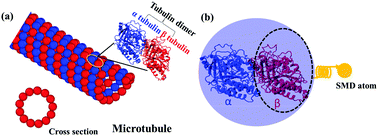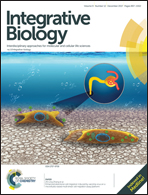Effect of amino acid mutations on intra-dimer tubulin–tubulin binding strength of microtubules†
Abstract
Energetic interactions inside αβ-tubulin dimers of a microtubule (MT) with atomic resolutions are of importance in determining the mechanical properties and structural stability of the MT as well as designing self-assembled functional structures from it. Here, we carry out several comprehensive atomistic simulations to investigate the interaction properties within αβ-tubulin dimers and effect of residue mutations on the intra-dimer tubulin–tubulin (IDTT) binding strength. Results indicate that the force-displacement responses of the dimer could be roughly divided into three stages involving increasing, decreasing, and fluctuating forces. Energetic analysis shows that electrostatic interactions dominate the IDTT binding strength. Further per-residue energetic analysis shows that the major part of the interface interaction energy (approximately 72% for α-tubulin and 62% for β-tubulin) comes from amino acid residues with net charges, namely arginine (ARG), lysine (LYS), glutamic acid (GLU), aspartic acid (ASP). Residue mutations are completed for ARG105 on α-tubulin and ASP251 on β-tubulin to study the effect of mutations on the IDTT binding strength. Results indicate that stiffness, rupture force, and interface interaction energy of αβ-tubulin dimer can be improved by up to 28%, 13% and 28%, respectively. Overall, our results provide a thorough atomistic understanding of the IDTT binding strength within αβ-tubulin heterodimers and help pave the way for eventually designing and controlling the self-assembled functional structures from MTs.



 Please wait while we load your content...
Please wait while we load your content...